Rice is one of the world’s most produced grains and has many different types of cooking techniques. Especially in Asian countries, cooking dishes with rice, whether white rice or brown rice is very common. Among all types of rice recipes, fluffy Persian rice is one of the most delicious options for dinner or lunch served alongside a bowl of stew.
About This Recipe
Basically in Iran, rice is served with a bowl of stew or as a Tahchin, as well as other mixed rice dishes such as Baghali Polo and Sabzi Polo. Typically Persian rice can be prepared with two different methods: Kateh and steaming. If it is the first time you want to cook Iranian rice, you may be a little confused, but don’t worry, By following these simple steps, you can have tender, fragrant, and fluffy rice.
The Different Types of Rice
There are different criteria for classifying types of rice and they are divided into several categories based on length and shape, texture after cooking, taste, and color.
Types of rice based on length and shape:
- Long grain rice: This rice has grains whose length is at least 3 to 4 times the grain width.
- Medium grain rice: This rice is medium in height compared to long grain rice.
- Short grain rice: This rice has the shortest length and creates a sticky texture when cooked, unlike the previous two categories.
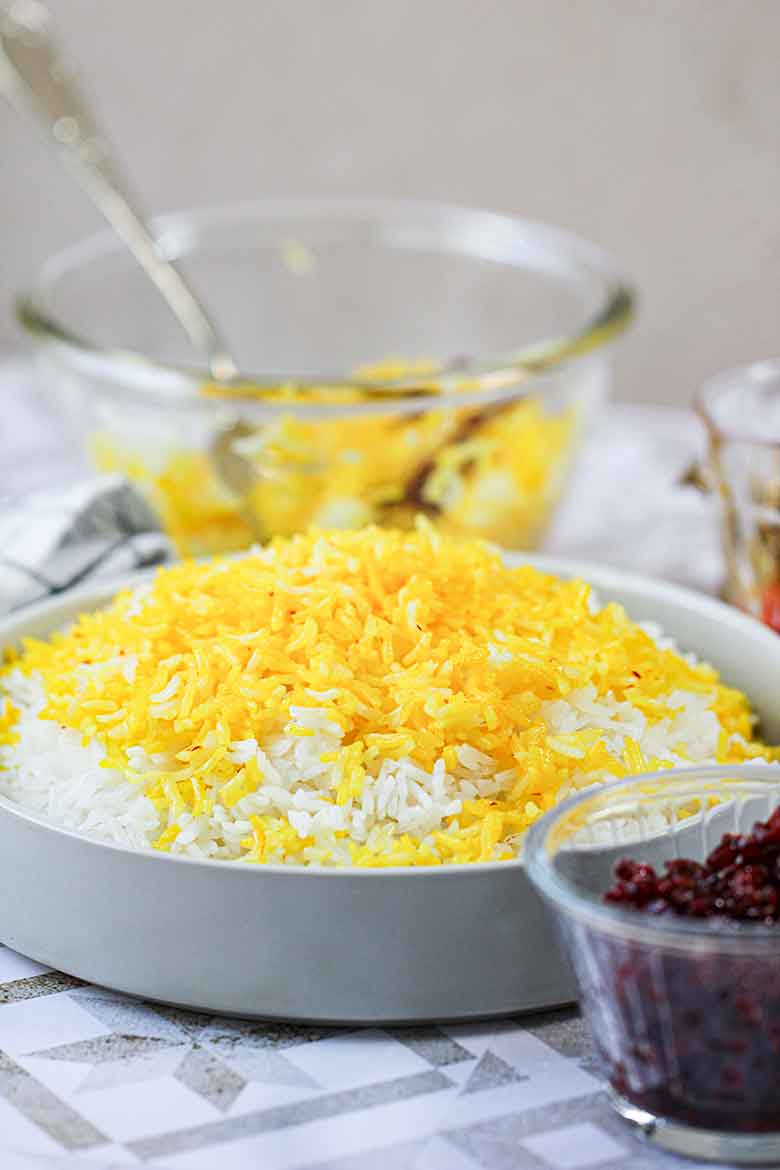
Different Types of Persian Rice
Iranian rice is grown in North Iran mostly in Gilan and Mazandaran. Tarom, Doodi, and Domsiah are among the most popular Iranian rice. You can easily find fragrant Peraisn rice in Iranian grocery stores. If you don’t have Iranian long-grain rice in hand, basmati rice is the best option to replace it. Iranian rice is typically cooked in two ways: boiling and cooking. Rice cooked with these two methods is called Chelo (steamed rice) and Kateh (easy one-pot rice dish). Kateh rice is easier to cook and less likely to fail.
What Do You Need to Cook Persian Rice
- Rice: Long-grain Iranian rice is the best choice for this recipe, but feel free to use long-grain basmati rice instead. The word “basmati” actually means fragrant, this rice has been cultivated for thousands of years. This type of rice has the longest grains of any rice and they will nearly double in size throughout the cooking process. It has a fluffy texture, a mild taste, and a pleasant aroma, which is suitable for Iranian food recipes.
- Vegetable oil: Use a little oil during cooking to prevent the rice from sticking to the pot.
- Salt: Rice flavor is enhanced by adding salt.
- Bloomed saffron: When rice is cooked you can mix a few tablespoons of rice with bloomed saffron and use it as the topping.
- Slivered almonds and pistachios: Soak the slivered almonds and pistachios in rose water for 30 minutes and then fry with a little oil for 1-2 minutes and use for topping.
- Dried barberries: You can typically find dried barberries at Middle Eastern grocery stores. A good barberry is bright red and beautiful in color, so avoid buying barberries that are dark in color.
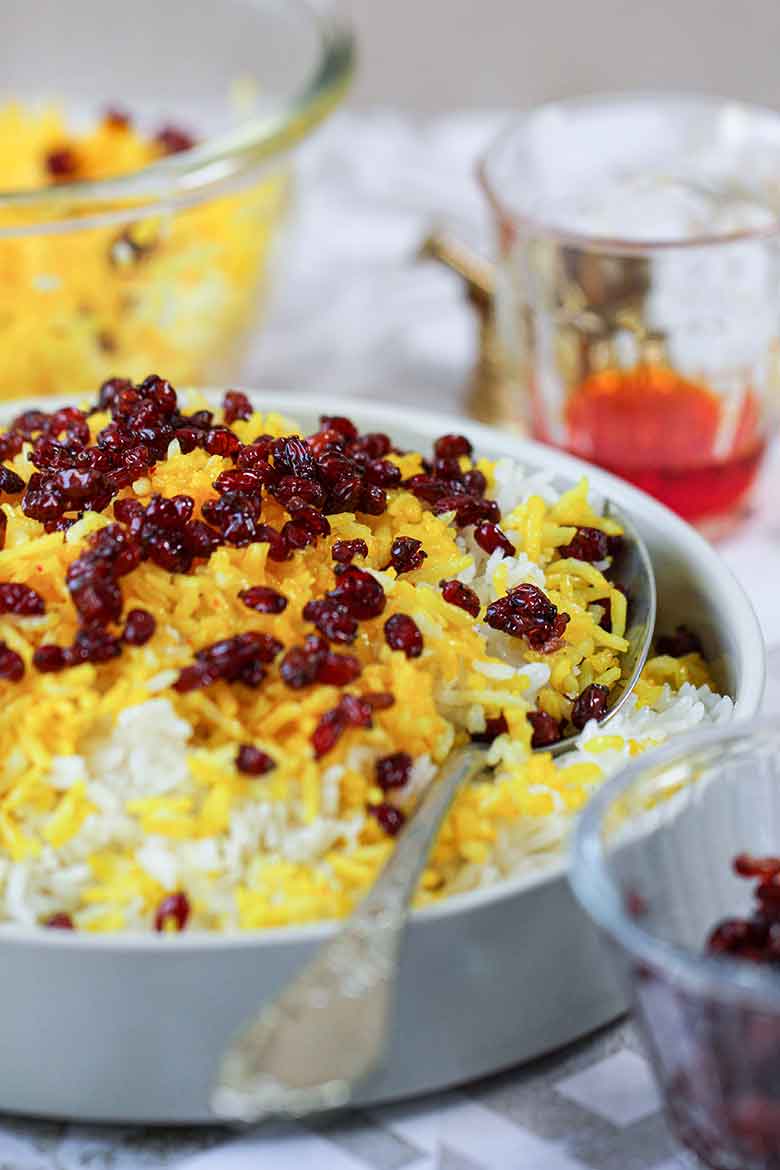
How to Cook Persian Rice? (Persian Steamed Rice or Chelo)
- Rinse rice until the water is clear. Soak rice in a large bowl of water. Add 1 tablespoon salt and stir to dissolve. Let it sit for 1-2 hours.
- Drain the soaked rice. Add fresh water into a pot. For every cup of rice add two cups of water. Place the pot on the stove over medium-high heat and bring to a boil. Add 1 tablespoon of salt to the boiling water. Add drained rice to the pot of boiling water and give a quick stir. The rice is done after 8-10 minutes when it begins to rise to the top and the water comes back to a boil. Check the rice is cooked by trying a grain.
- Break one grain in half. Rice should be soft on the outside but slightly hard in the middle. Pour rice into the colander to drain; then set aside. In a large pot heat 2 tablespoons of oil or butter. Arrange potato slices or Lavash naan. Pour the drained rice back into the pot and shape it into a pyramid. Place the pot on medium-high heat directly on the stovetop. Cover the lid with a clean dishcloth and put it on the pot. Cover the pot and cook over medium heat until the rice begins to steam. Then lower the heat and cook for about 40-45 minutes or until the crust forms.
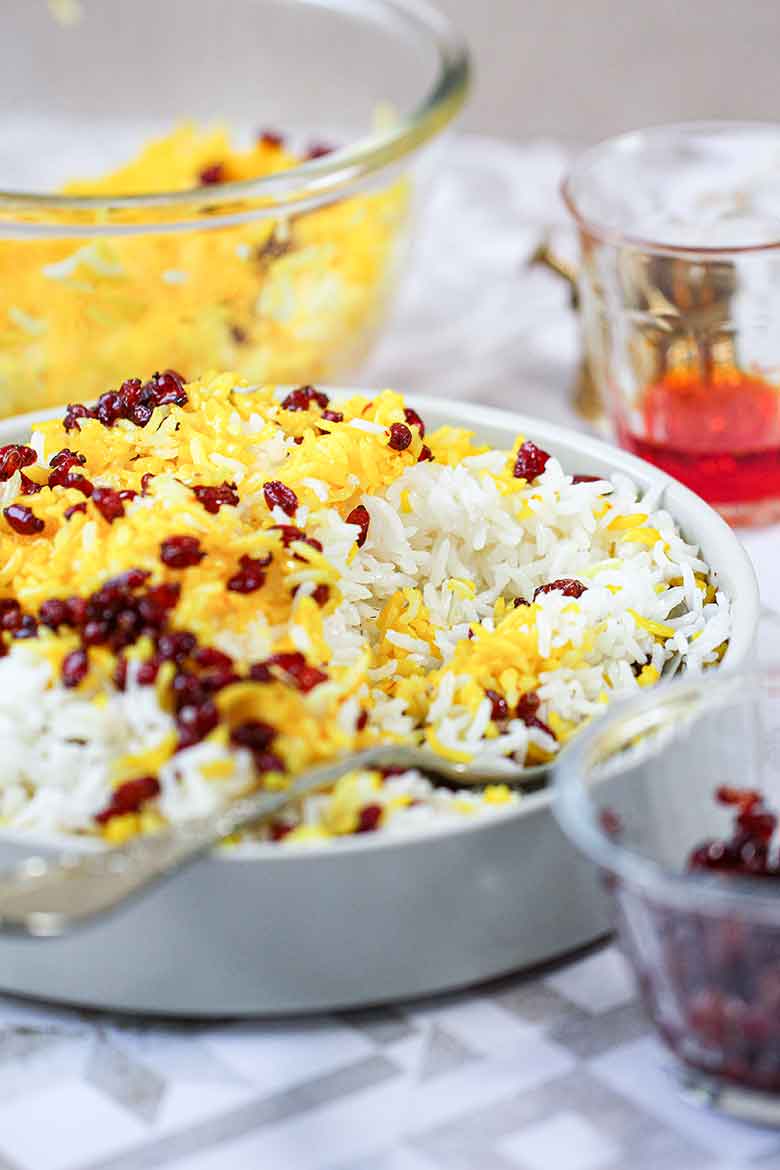
Kateh Recipe (Easy Persian Rice Cooking Method)
- Persian rice is cooked with two techniques, Kateh and steaming. Kateh is an easy one-pot rice dish cooked with water, oil, and salt. To have fluffy and flavor-packed Kateh rice, first, rinse the rice thoroughly. Soak rice in a bowl of water. Add 1 teaspoon salt and stir to dissolve. Let it sit for 30 minutes to 1 hour.
- Drain rice. Add rice to the pot. Add water to cover the surface of the rice with 1 inch of water. Add a little salt and two tablespoons of vegetable oil.
- Bring to a boil uncovered, then reduce heat to a simmer until most of the water is absorbed. Cover the pot with a kitchen towel and a lid. Cook for 30-40 minutes on medium-low heat or until the rice is fluffy and tender.
- Place a non-stick pot on the heat and pour the rice. For a less sticky and more fluffy rice use 2/3 cup of water for a cup of rice.
Expert Tips
- You can serve Kateh or steamed rice with Almost all of the Persian kebabs, or stews.
- Kateh is typically cooked with Iranian rice, but if you use Jasmine rice or Basmati rice; you may need to soak it for a few hours.
- If you use Doodi rice (Persian smoked rice); Avoid rinsing it too much so as not to lose its aroma.
FAQs
What Is the Difference Between Basmati Rice and Persian Rice?
Persian rice has a richer smell and taste, and it also requires more skill to cook with, as it tends to turn sticky and mushy with ease. It is recommended to soak Iranian rice in some water and salt for at least an hour before cooking but it is not necessary to soak basmati rice in advance.
What Are the Names of Persian Rice?
You can find different types of Iranian rice in local grocery stores, each having its own unique characteristics and flavors. Some of the most common names of Iranian rice that you may find are the following: Tarom, Tarom Mahali, Domsiah, Doodi, and Gerdeh.
How to Serve Persian Rice?
Take 5 or 6 tablespoons of cooked rice and mix it with 2 teaspoons of bloomed saffron. Rinse the barberries with cold water to remove any dirt or debris. Drain, and set aside. Put 2 tablespoons of butter or vegetable oil in a small frying pan on medium heat. Add barberries to the pan and saute for 1 or 2 minutes. Serve Persian rice and top it with saffron rice and sauteed barberries.
Did you like the Persian rice recipe? Leave your comment below and If you make this recipe, be sure to tag your photos #yummynotes
Looking for More Persian Recipes?
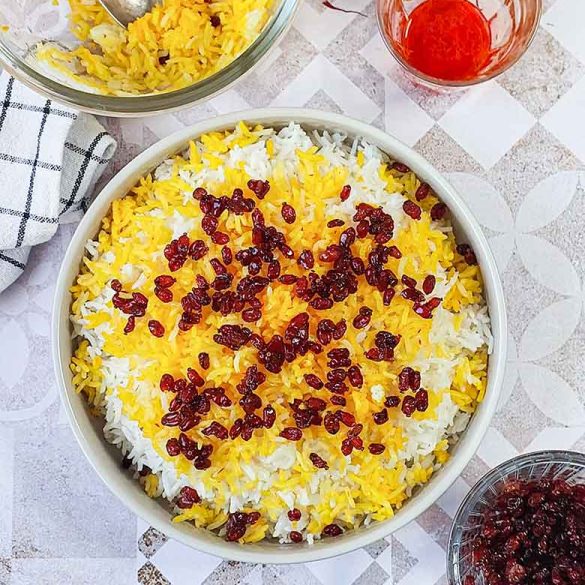
Ingredients
- 3 cups long grain rice
- Water
- 2-3 tablespoons vegetable oil
- Salt, as needed
- 1 lavash naan(optional)
- 3 teaspoons Bloomed saffron (optional)
- Dried barberries (optional)
Instructions
Step 1
Rinse rice until the water is clear. Soak rice in a large bowl of water. Add 1 tablespoon salt and stir to dissolve. Let it sit for 1-2 hours.
Step 2
Drain the soaked rice. Add fresh water into a pot. For every cup of rice add two cups of water. Place the pot on the stove over medium-high heat and bring to a boil. Add 1 tablespoon of salt to the boiling water.
Step 3
Add drained rice to the pot of boiling water and give a quick stir. The rice is done after 8-10 minutes when it begins to rise to the top and the water comes back to a boil. Check the rice is cooked by trying a grain.
Step 4
Break one grain in half. Rice should be soft on the outside but slightly hard in the middle. Pour rice into the colander to drain; then set aside. In a large pot heat 2 tablespoons of oil or butter. Arrange potato slices or Lavash naan. Pour the drained rice back into the pot and shape it into a pyramid.
Step 5
Place the pot on medium-high heat directly on the stovetop. Cover the lid with a clean dishcloth and put it on the pot. Cover the pot and cook over medium heat until the rice begins to steam. Then lower the heat and cook for about 40-45 minutes or until the crust forms.

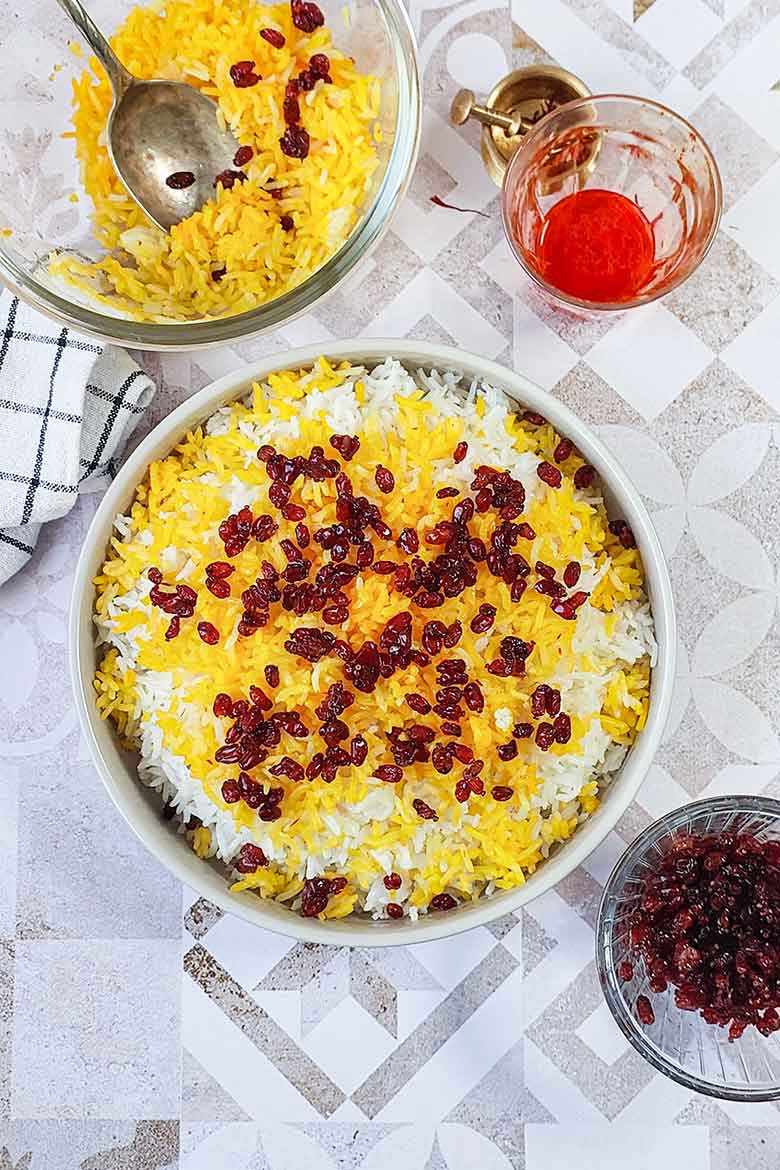

2 comments
This rice looks absolutely delicious, but this is also the first time I’ve heard of smoked rice, which sounds incredible. I will definitely have to try to find something. Thanks for the lovely recipe and write-up!
This recipe is absolutely INSANELY delicious!